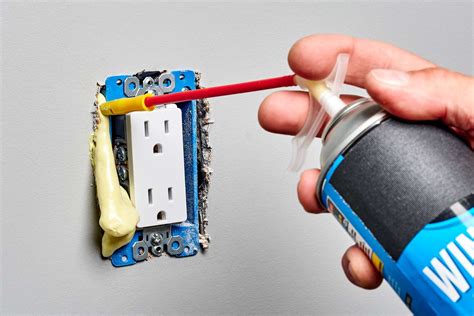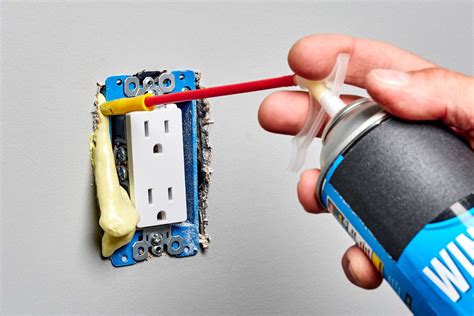can you spray foam around electrical boxes Yes, you can cover cables with expanding foam. Expanding spray foam is used frequently in the building industry to seal gaps that otherwise might compromise insulation integrity. There is no evidence to suggest that spray foam reacts . Since 1969, Wayne's Roofing of Sumner, WA, has been setting the standard for roofing excellence in the Pacific Northwest. From Conception to Completion, Our Commitment to you .
0 · spray foam insulation over electrical
1 · spray foam for electrical outlets
2 · sealing electrical outlets spray foam
3 · insulating electrical outlets spray foam
4 · insulate electrical outlets inside home
5 · foam insulation for electrical outlets
6 · foam gaskets for electrical outlets
7 · expanding foam around electrical cables
Description: This ABS project box brings a better customizable experience. 1.Made of ABS material. Sturdy and terrific for making those DIY projects. Easy to drill and shape openings for many items like meters, sockets, LEDs and so on. 2.Many screw holes inside in various places.
Yes, it’s generally safe to use spray foam around electrical wires when you do it correctly. When sprayed properly, the foam provides a seal that can prevent air leaks and increase energy efficiency.Yes, you can cover cables with expanding foam. Expanding spray foam is used frequently in the building industry to seal gaps that otherwise might compromise insulation integrity. There is no evidence to suggest that spray foam reacts . While you won’t be able to access encapsulated wires again, spray foam is safe to spray against your electrical wiring. You can also run new wires in your home without . Expanding spray foam without carefully planning can damage electrical wiring. You can prepare any space you want to fill with expanding foam by routing wiring in conduit and making sure not to overfill the cavities where .

Use air sealing electrical boxes if available to minimize the amount of foam migrating into the boxes from the back and sides. 4. Use potlight enclosures that are .If there’s plenty of room around your box, you may spray the foam behind it to fill any gap between it and the outside wall surface. We suggest a low-expanding foam because it fills midsized and small gaps uniformly without the need to . The electrical code forbids you from filling the air in the box with spray foam. You've done a pretty good job of keeping the foam out of the box. As long as you don't let the foam encroach on the volume of the box, everything . To insulate around electrical boxes, use foam gaskets or putty pads. Foam gaskets fit around the box and behind the cover plate, while putty pads adhere directly to the back of the cover plate.
Gaps around ceiling boxes must be sealed with an intumescent fireblocking caulk or foam. Ordinary spray foam burns too quickly, opening the gap and creating a chimney effect that feeds the fire. Intumescent caulk or foam, on the other hand, swells when heated so it prevents that airflow.Yes, it’s generally safe to use spray foam around electrical wires when you do it correctly. When sprayed properly, the foam provides a seal that can prevent air leaks and increase energy efficiency. Spray foam is a handy, easy-to-use insulator, but you can’t just use it everywhere. If you’re thinking about spraying it around your outlets and your electrical box, follow basic safety precautions and use it with care.Yes, you can cover cables with expanding foam. Expanding spray foam is used frequently in the building industry to seal gaps that otherwise might compromise insulation integrity. There is no evidence to suggest that spray foam reacts with electrical insulation or damages the circuit.
spray foam insulation over electrical
While you won’t be able to access encapsulated wires again, spray foam is safe to spray against your electrical wiring. You can also run new wires in your home without demolishing your insulation or drywall.
Expanding spray foam without carefully planning can damage electrical wiring. You can prepare any space you want to fill with expanding foam by routing wiring in conduit and making sure not to overfill the cavities where spray foam is being extended. Use air sealing electrical boxes if available to minimize the amount of foam migrating into the boxes from the back and sides. 4. Use potlight enclosures that are compatible with spray foam and do not rely on air movement through the enclosure for .
If there’s plenty of room around your box, you may spray the foam behind it to fill any gap between it and the outside wall surface. We suggest a low-expanding foam because it fills midsized and small gaps uniformly without the need to apply undue force to surrounding materials. The electrical code forbids you from filling the air in the box with spray foam. You've done a pretty good job of keeping the foam out of the box. As long as you don't let the foam encroach on the volume of the box, everything should be OK. To insulate around electrical boxes, use foam gaskets or putty pads. Foam gaskets fit around the box and behind the cover plate, while putty pads adhere directly to the back of the cover plate. Gaps around ceiling boxes must be sealed with an intumescent fireblocking caulk or foam. Ordinary spray foam burns too quickly, opening the gap and creating a chimney effect that feeds the fire. Intumescent caulk or foam, on the other hand, swells when heated so it prevents that airflow.
spray foam for electrical outlets
Yes, it’s generally safe to use spray foam around electrical wires when you do it correctly. When sprayed properly, the foam provides a seal that can prevent air leaks and increase energy efficiency.
Spray foam is a handy, easy-to-use insulator, but you can’t just use it everywhere. If you’re thinking about spraying it around your outlets and your electrical box, follow basic safety precautions and use it with care.Yes, you can cover cables with expanding foam. Expanding spray foam is used frequently in the building industry to seal gaps that otherwise might compromise insulation integrity. There is no evidence to suggest that spray foam reacts with electrical insulation or damages the circuit.
electric guitar shipping box
While you won’t be able to access encapsulated wires again, spray foam is safe to spray against your electrical wiring. You can also run new wires in your home without demolishing your insulation or drywall. Expanding spray foam without carefully planning can damage electrical wiring. You can prepare any space you want to fill with expanding foam by routing wiring in conduit and making sure not to overfill the cavities where spray foam is being extended.
Use air sealing electrical boxes if available to minimize the amount of foam migrating into the boxes from the back and sides. 4. Use potlight enclosures that are compatible with spray foam and do not rely on air movement through the enclosure for .If there’s plenty of room around your box, you may spray the foam behind it to fill any gap between it and the outside wall surface. We suggest a low-expanding foam because it fills midsized and small gaps uniformly without the need to apply undue force to surrounding materials. The electrical code forbids you from filling the air in the box with spray foam. You've done a pretty good job of keeping the foam out of the box. As long as you don't let the foam encroach on the volume of the box, everything should be OK.
sealing electrical outlets spray foam
insulating electrical outlets spray foam
insulate electrical outlets inside home
foam insulation for electrical outlets

VEVOR NEMA Steel Enclosure, 24 x 24 x 8'' NEMA 4X Steel Electrical Box, IP66 Waterproof & Dustproof, Outdoor/Indoor Electrical Junction Box, with Mounting Plate
can you spray foam around electrical boxes|foam gaskets for electrical outlets